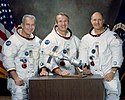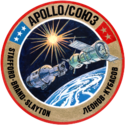Apollo (ASTP)
| Apollo | |||
 | |||
| Statistik för uppdraget | |||
|---|---|---|---|
| NSSDC-ID | 1975-066A[1] | ||
| Farkostens namn | Apollo | ||
| Anrop | Apollo | ||
| Varaktighet | 9 dagar, 1 time, 28 minuter, 24 sekunder | ||
| Uppskjutning | |||
| Raket | Saturn IB | ||
| Uppskjutningsramp | Kennedy Space Center LC-39B | ||
| Uppskjutning | 15 juli 1975, 19:50 UTC | ||
| Landning | |||
| Landning | 24 juli 1975, 21:18:00 UTC | ||
| Landningsplats | 21°52′N 162°45′V / 21.867°N 162.750°V | ||
| Omloppsbana | |||
| Varv runt jorden | 148 st | ||
| Distans | ~5 990 000 km | ||
| Dockning | |||
| Dockning | 17 juli 1975, 16:19:09 UTC | ||
| Ur dockning | 19 juli 1975, 15:26:12 UTC | ||
| Tid dockad | 1 dag, 23 timmar, 7 minuter, 3 sekunder | ||
| Besättning | |||
| Besättning | Thomas P. Stafford (4) Vance D. Brand (1) Deke Slayton (1) | ||
 V-H: Slayton, Brand, Stafford | |||
| Kronologi | |||
| |||
Apollo (ASTP), även kallad Apollo 18, var en amerikansk Apollofarkost som under Apollo-Sojuz-testprojektet dockade med den sovjetiska rymdfarkosten Sojuz 19.
Farkosten sköts upp med en Saturn IB-raket från Kennedy Space Center den 15 juli 1975. Med sig hade man även den dockningsmodul som skulle utgöra luftsluss mellan de båda farkosterna.
Den 17 juli 1975 dockade man med Sojuz 19 och tillbringade två dagar tillsammans.
Apollo återinträdde i jordens atmosfär och landade i Stilla havet den 24 juli 1975.
Besättning
Besättning
- Thomas P. Stafford (4)
- Vance D. Brand (1)
- Deke Slayton (1)
Reservbesättning
Se även
Källor
- ^ ”NASA Space Science Data Coordinated Archive” (på engelska). NASA. https://nssdc.gsfc.nasa.gov/nmc/spacecraft/display.action?id=1975-066A. Läst 27 mars 2020.
| |||||||||||||||||||
| ||||||||||||||||||||||||||||||||
Media som används på denna webbplats
Författare/Upphovsman: Pascal (Flickr user: pasukaru76), Licens: CC0
Vostok spacecraft replica at the Technik Museum Speyer, Germany.
These three NASA astronauts are the American flight crew for the 1975 Apollo Soyuz Test Project ASTP mission. The prime crewmen for the joint U.S.-Soviet Union space flight are, left to right, Donald K. Slayton, docking module pilot; Vance D. Brand, command module pilot; and Thomas P. Stafford, commander. They are in their space suits with a model of the Apollo-Soyuz capsules in docking mode in front of them. Image ID: S74-15241
This is the emblem for the third manned Skylab mission.
- It will be a mission of up to 56 days. Skylab is an experimental space station consisting of a 100-ton laboratory complex in which medical, scientific and technological experiments will be performed in Earth orbit. The members of the crew will be astronaut Gerald P. Carr, commander; scientist-astronaut Edward G. Gibson, science pilot; and astronaut William R. Pogue, pilot.
- The symbols in the patch refer to the three major areas of investigation proposed in the mission.
- The tree represents man's natural environment and relates directly to the Skylab mission objectives of advancing the study of Earth resources.
- The hydrogen atom, as the basic building block of the universe, represents man's exploration of the physical world, his application of knowledge, and his development of technology. Since the sun is composed primarily of hydrogen, it is appropriate that the symbol refers to the solar physics mission objectives.
- The human silhouette represents mankind and the human capacity to direct technology with a wisdom tempered by regard for his natural environment. It also directly relates to the Skylab medical studies of man himself.
- The rainbow, adopted from the Biblical story of the flood, symbolizes the promise that is offered man. It embraces man and extends to the tree and the hydrogen atom emphasizing man's pivotal role in the conciliation of technology with nature.
This is the American crew insignia of the joint United States-USSR Apollo-Soyuz Test Project (ASTP). Of circular design, the insignia has a colorful border area, outlined in red, with the names of the five crew members and the words Apollo in English and Soyuz in Russian around an artist's concept of the Apollo and Soyuz spacecraft about to dock in Earth orbit. The bright sun and the blue and white Earth are in the background. The white stars on the blue background represent American astronauts Thomas P. Stafford, commander; Vance D. Brand, command module pilot; and Donald (Deke) K. Slayton, docking module pilot. The dark gold stars on the red background represent Soviet cosmonauts Aleksey A. Leonov, commander, and Valeriy N. Kubasov, engineer.
STS-1 CREW PATCH
This is the official insignia for the first Space Shuttle orbital flight test (STS-1). Crew of the 102 Columbia on STS-1 was Astronauts John W. Young, commander, and Robert Crippen, pilot. The art work was done by artist Robert McCall.









